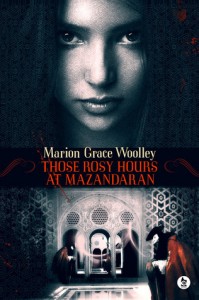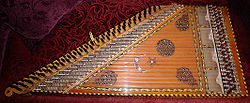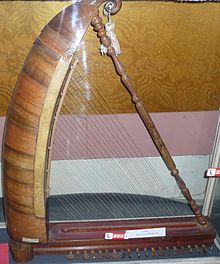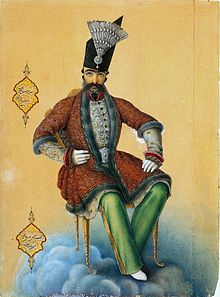 Today’s guest post is by author Marion Grace Woolley. Her new book, Those Rosy Hours at Mazandaran, is the subject of today’s review. Because the book is a chilling imagining of the life of Erik from the Phantom of the Opera before he went to Paris, music plays an important part of the story. Read on…
Today’s guest post is by author Marion Grace Woolley. Her new book, Those Rosy Hours at Mazandaran, is the subject of today’s review. Because the book is a chilling imagining of the life of Erik from the Phantom of the Opera before he went to Paris, music plays an important part of the story. Read on…
On That Note
by Marion Grace Woolley
“[Music is] the purest of all architecture. Buildings are naught but clay and mud, which time eventually reduces them to once again. Scores, now they are designed of an altogether higher material. The universe itself is built on the chords and harmonies of gods.”
When you set out to write the early life of one of literature’s great musical geniuses, as I did in Those Rosy Hours at Mazandaran, you’ve got to learn to strike the right chord.
In 1850s Northern Iran, my two main characters, Afsar and Eirik, share many things in common, except that Afsar has little musical ability, whereas Eirik has mastered music itself.
Part of my researching whilst creating the world of Afsar’s Mazandaran was to look into the instruments of traditional Persian music. Here, I’d like to introduce you to a few of them, and to give you a taste of what they sound like.
 Qanun: This is the instrument that Afsar tries to play, with little success. It is a wooden board of strings, played throughout the Middle East and Central Asia, similar to the European zither. It is most commonly plucked by hand, using pointy metal rings on the index fingers, which act as plectrums. You can listen to a sample here.
Qanun: This is the instrument that Afsar tries to play, with little success. It is a wooden board of strings, played throughout the Middle East and Central Asia, similar to the European zither. It is most commonly plucked by hand, using pointy metal rings on the index fingers, which act as plectrums. You can listen to a sample here.
 Chang: Eirik has a harp in his music room in Tehran, which Afsar mistakes for a Persian chang, or Angel Harp. It is said to have been a favoured instrument of the Shahs of the earlier Sasanian dynasty. There is an evocative example here, which claims that the instrument is around 4,000 years old and originated in Mesopotamia.
Chang: Eirik has a harp in his music room in Tehran, which Afsar mistakes for a Persian chang, or Angel Harp. It is said to have been a favoured instrument of the Shahs of the earlier Sasanian dynasty. There is an evocative example here, which claims that the instrument is around 4,000 years old and originated in Mesopotamia.
Tonbak: This provides the rythm for Persian music. The Tonbak is a wooden drum stretched with sheep or goatskin. Rather than simply hitting the instrument with the flat of their hands, musicians tend to drum their fingers against it, even clicking them, as in this example.
![]() Duduk: Behrang and Emad, the Shah’s clowns in my story, are said to torture this instrument. It is a reed tube, similar to a clarinet, originating from neighbouring Armenia to the north of Mazandaran. It has a very distinctive sound, used to great effect by Hans Zimmer and renowned duduk player Djivan Gasparyan in The Gladiator soundtrack.
Duduk: Behrang and Emad, the Shah’s clowns in my story, are said to torture this instrument. It is a reed tube, similar to a clarinet, originating from neighbouring Armenia to the north of Mazandaran. It has a very distinctive sound, used to great effect by Hans Zimmer and renowned duduk player Djivan Gasparyan in The Gladiator soundtrack.
One of the nicest surprises that has come through publishing Those Rosy Hours at Mazandaran is that it has been turned into an audiobook. Whilst writing the novel, I included two traditional lullabies, one French and one Persian. Emma Newman, the narrator of the audiobook, took the wonderful decision to sing these songs, and we had them sung by native speakers so that she could learn to pronounce them correctly. I will never forget hearing Nadia Tariqi, our Iranian translator, sing it for the first time. It was only a short couple of lines, but the sound of her singing was instantly evocative in ways that simply reading the words could never be.
It seems strange to say, but music and sound have had such a huge part to play between the pages of this novel.
 About Marion Grace Woolley
About Marion Grace WoolleyMarion Grace Woolley is the author of three previous novels and a collection of short stories. In 2009, she was shortlisted for the Luke Bitmead Bursary for New Writers. She balances her creative impulses with a career in International Development; she has worked and traveled across Africa, Australia, Armenia, and a few other places beginning with ‘A’. She is an associate member of the Society of Authors, and is currently at work on her fifth novel.
Follow Marion on Twitter @AuthorMGW
~~~~~~GIVEAWAY~~~~~~
The author is giving away a copy of Those Rosy Hours at Mazandaran to one lucky winner. This giveaway is International!
a Rafflecopter giveaway


